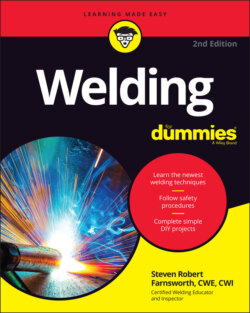Читать книгу Welding For Dummies - Steven Robert Farnsworth - Страница 23
Mig welding
ОглавлениеMig welding is another arc welding technique. You may also hear mig welding referred to as gas metal arc welding (GMAW) or wire welding. Mig welding is becoming more and more popular, for several reasons. At the top of the list is the fact that most people find mig welding to be easier to pick up than stick and tig. Another big reason is the speed; done correctly, mig welding can be quite a bit faster than stick or tig welding thanks to its continuously fed wire electrode, which doesn’t require changing nearly as often as the stick electrodes used in stick welding. You can just keep right on welding without having to stop and change your electrode. Over the course of a welding project, that can definitely save you quite a lot of time.
Proponents of mig welding also cite the low amount of slag and spatter that mig produces. That makes for a more pleasant welding experience, and a much more pleasant cleanup experience. The low chance of distortion (unwanted changes in a piece of metal’s shape) is also trumpeted by those who love mig welding. Because the process is faster, you don’t need to apply as much heat to the weld area for as long, so the metal is less likely to bend and twist in nasty ways.
Of course, mig welding also has its downsides. For starters, mig welding equipment is more complex than stick welding equipment, so it’s quite a bit more expensive. The handheld part of the mig welding equipment (called the mig gun) is often big and bulky, so it’s usually tough to mig weld in tight spaces. Mig welding also relies on the use of a shielding gas to keep atmospheric contaminants away from the weld area, so the process doesn’t really work very well outdoors (especially with any kind of breeze).
I save the details of the mig welding process for Chapters 9 and 10, but generally speaking, here’s how it works: A wire feeder continuously feeds the wire electrode to the weld area at a speed you control. That produces a steady molten stream that you can easily direct however you want on the surface of the metal you’re welding. The weld is completely covered with a shielding gas (usually argon) to prevent impurities from fouling up the quality of the weld; you control the flow of the shielding gas to suit your project’s needs.
